Rare Minolta cameras still available on the market
NOTE! Since these cameras have been phased out, you will only find used versions. It is better to do this on sites such as Amazon and eBay, where sellers can provide a tested product.
If you haven't witnessed the heyday of film photography, then you probably want to know about Minolta film cameras from a famous Japanese manufacturer. The company created premium photographic equipment and has greatly influenced modern photographic technology.
The brand achieved popularity after the release of the first 35mm DSLR camera system with built-in autofocus. If you’re lucky enough, you can find a basic body only for $100. Over a decade ago, Minolta called time on their business activity, but their devices are still in high demand even among seasoned photographers.
For photographers, who want to make strides in film photography, Minolta is the best camera brand to start with, as the lens mount hasn't changed much since the second half of the last century. Sometimes modern Sony lenses can be mounted on older Minolta bodies with just slight limitations in functionality. The company found it difficult to transition to digital products and was acquired by Sony in 2006 when it started to release its digital cameras.
From shutter-priority mode to built-in image stabilization – Minolta was the pioneer in the production of technologically advanced and innovative film cameras and lenses. Thus, a Minolta camera is not just good to use; such devices occupy a special place in photography history and enjoy immense popularity among collectors and connoisseurs of classic photographic art.
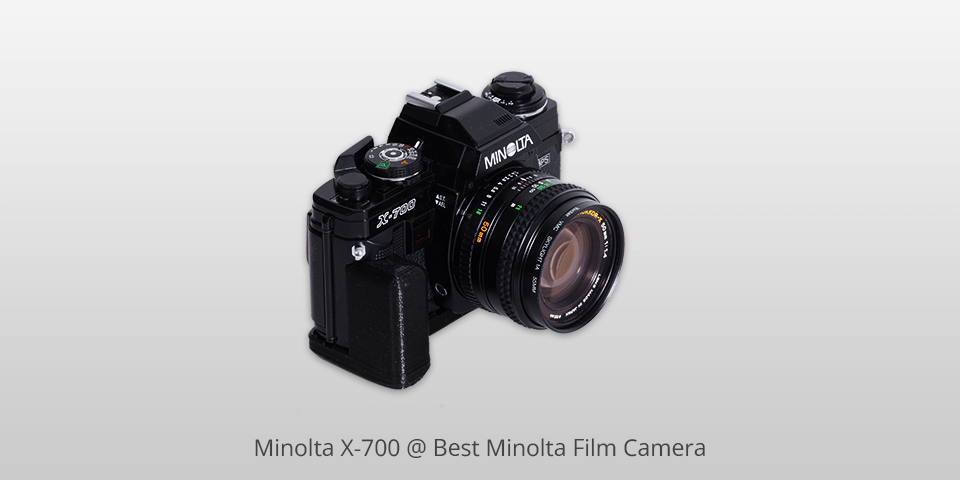
Sensor: SLR | Exposure: manual / automatic | Film Format: 35 mm | Shutter speed: 1 / 1000 – 4 sec
As one of the most popular Minolta 35mm cameras, the award-winning X-700 allows you to enjoy the process without adjusting the aperture and shutter speed manually. Besides, it can be programmed for automatic exposure, which is great if you frequently shoot in difficult lighting conditions. With the inclusion of a manual mode, the Minolta X-700 is easy to use and navigate for both professional and amateur photographers.
The feature set includes programmed dedicated auto flash (self-timer); blocking, exposure composition, and correction up to two stops, safe film loading indicator, and frame counter. What makes it stand out from the X line is the presence of a program mode, excellent metering in program priority and aperture modes, and one of the brightest viewfinders in the line.
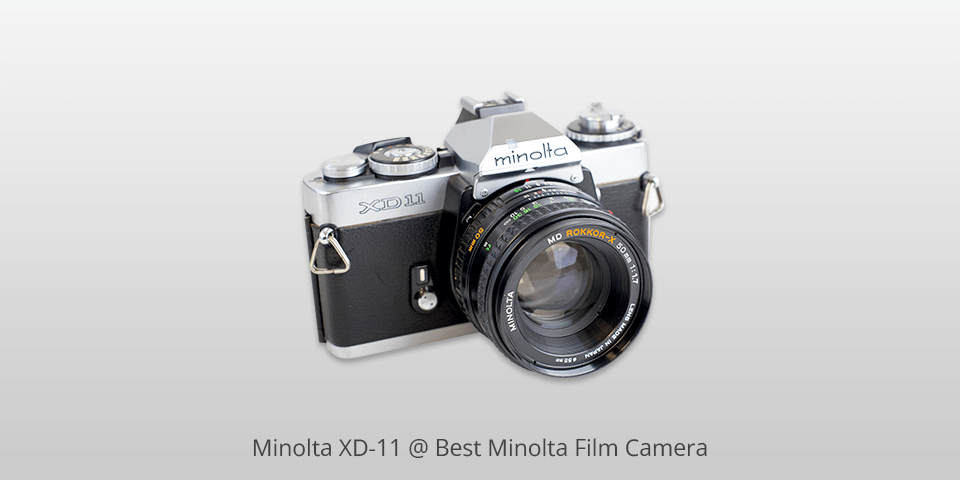
Sensor: SLR | Exposure: manual / automatic | Film Format: 35 mm | Exposure range: EV 1 – EV 18
In the 1970s, Minolta and Leica decided to become partners and share patents, technologies, and product developments. The second model from the collaboration, namely, the XD 11, was the world's first DSLR with aperture priority and shutter speed modes, and with full manual metering, which took film photography and shooting to the next level. Leica used the XD chassis to create the R-series DSLR cameras.
The ISO range and metering capabilities of a camera are fantastic, allowing you to achieve perfect exposures with ease. The final control metering system performs a second reading after the shutter is turned on to ensure accurate exposure. A well-designed metal body is lightweight and the camera has a stylish metal finishing. The XD was the last top-quality manual focus camera in a metal body before the company switched to plastic.
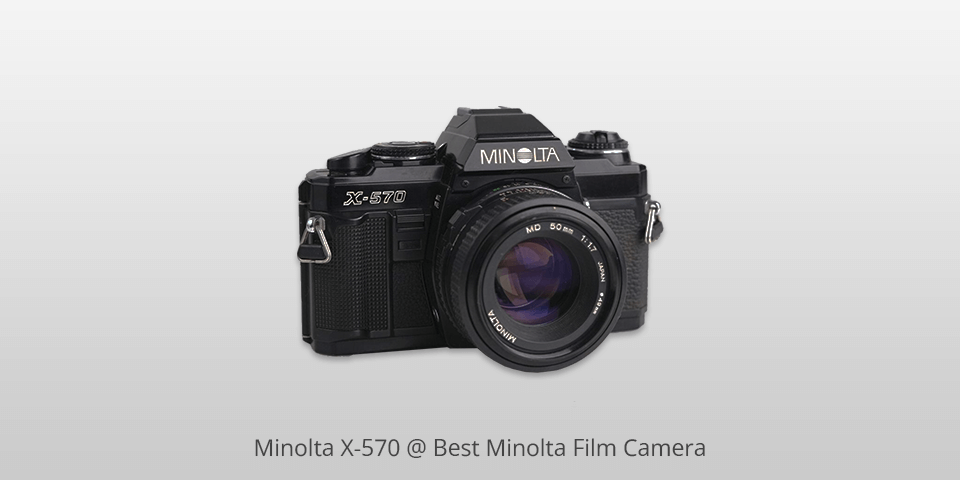
Sensor: SLR | Exposure: manual / semiautomatic | Film Format: 35 mm | Shutter speed: 1 / 1000 – 4 sec (1 sec in manual mode)
This is the successor to the popular X-700. The X-570 has established itself as Minolta entry-level camera. It has the 12 – 3200 ISO range, depth of field preview, a more sophisticated viewfinder, double exposure lock, and a self-timer button. There's no program mode, but aperture priority offers some automatic exposure control, and the price makes this Minolta film camera great for beginners, giving you full creative control when ready.
The X-570 features Minolta shutter-priority and aperture-priority modes that bring digital elegance to a manual camera. Auto exposure lock helps you take multiple images at the same exposure. By clicking the Depth of Field preview button, you can evaluate a scene and receive fantastic results. The camera is fairly durable, being light and compact.
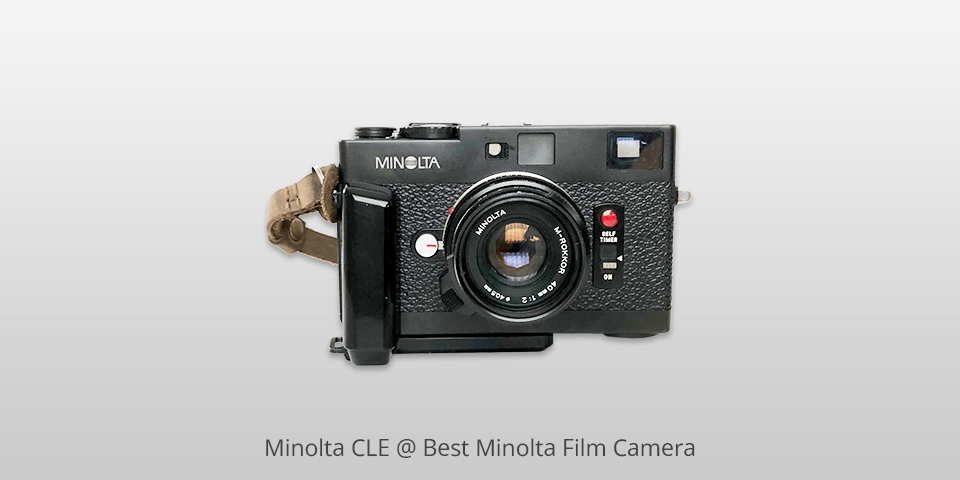
Sensor: SLR | Exposure: manual / automatic | Film Format: 35 mm | Exposure range: EV 1 – EV 18
This camera was also created in a partnership with Leica. Minolta CLE can be deservedly called the best rangefinder camera, allowing you to take great pictures without going the extra mile. It has an elegant Leica-type body with a precise focus and electronic features. It works in manual and digital modes with aperture and shutter priority. Besides, it uses an advanced flash and exposure system through the lens without involving film.
This Minolta camera is compatible with a limited range of lenses, such as the optically sharp and multi-layered Rokkor M. Leica still makes an M-mount lens. A large viewfinder with focal lengths of 28, 40 and 90mm makes it easy to build shots. The CLE used one of the most advanced rangefinders, thanks to the inclusion of aperture-priority autoexposure – a silicon photodiode meter measured the light reflected from the shutter curtain pattern.
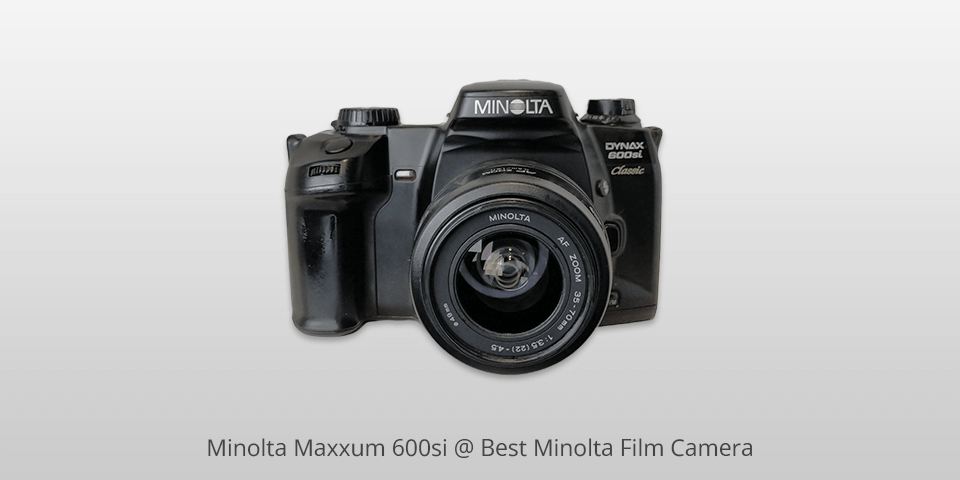
Sensor: SLR | Exposure: manual / automatic | Film Format: 35 mm | Exposure range: EV 0 – EV 20
Although the 600si was the first brand’s experiment with a return to knobs and dials instead of the ubiquitous wheel-button interface, its design is similar to today's DSLRs with vintage touches. To make it more stable, you can attach a separate handle. Many components and buttons have locks to prevent accidental pressing, and controls are backlit.
This Minolta film camera has many professional features, which should make the transition easier for those using digital devices. The shock-proof steel case is protected from atmospheric phenomena. The camera has a reliable viewfinder, while a 14-section metering system is excellent and offers accurate exposure calculations. With a wide range of shooting modes, you can use this camera for different photography genres.
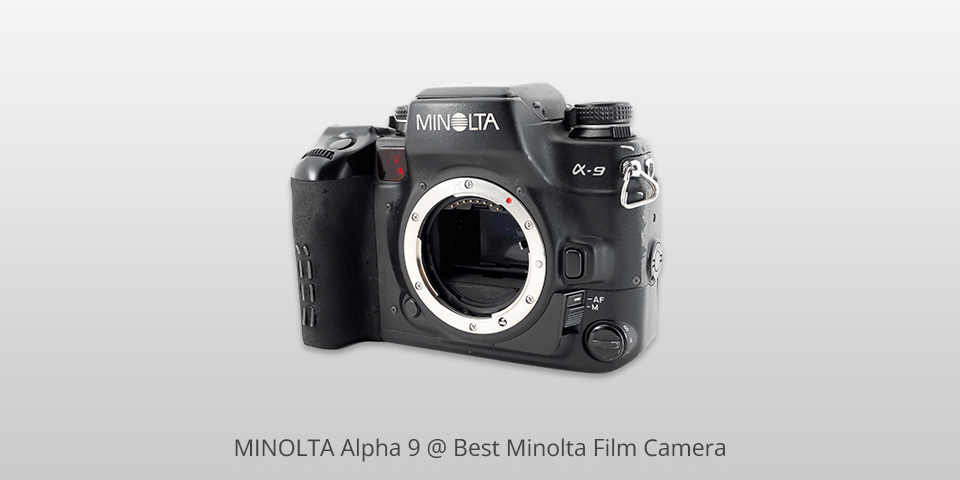
Sensor: SLR | Exposure: manual / automatic | Film Format: 35 mm | Exposure range: EV -1 – EV 18
Minolta’s professional-grade cameras can hardly stay on par with reputable Nikon and Canon models. Nevertheless, the Minolta A9 outperformed even professional models of other major manufacturers of the time. It combines excellence and durability in one body, being one of the best Minolta film cameras you can find.
The specification is eloquent: maximum shutter speed of 1 / 12000 second, stainless steel body, function dials, accounting and metering system, divided into 14 sections, so even beginners can discern the process. The camera is relatively modern. It was released at approximately the end of the era of film photography. The A9 has a familiar set of features for easy transition from digital shooting.

Sensor: SLR | Exposure: manual / automatic | Film Format: 35mm | Shutter speed: 1 / 2000 – 16 sec (4 sec with AE finder)
It belongs to the group of the best vintage cameras and stands out with universal functionality, a vintage look, and lots of features. It's also quite easy to use and master, offering an excellent manual focus mode with an ISO range and shutter speed that allows you to take a wide range of shots.
Minolta XK comes with interchangeable viewfinders and also has 11 focusing screens to help you achieve accurate metering for macro photography. Senswitch can turn off the measuring system to save battery charge. The aperture priority mode is easy to learn, and with the Minolta XK, you’ll get a good idea of the electronic cameras of the time.
| IMAGE | NAME | FEATURES | |
|---|---|---|---|

|
Minolta X-700
OUR CHOICE
|
CHECK PRICE → | |

|
Minolta XD-11
FOR PROS
|
CHECK PRICE → | |

|
Minolta X-570
AFFORDABLE
|
CHECK PRICE → |
While used cameras are available on different resources, their quality may vary a lot. In addition to these large marketplaces, some of the best places to look for vintage cameras in the US are Robert's Camera (UsedPhotoPro) in Indianapolis and KEH Camera in Smyrna. On these sites, you will receive a temporary warranty and free shipping on most products. Besides, there are buyer’s guides for film cameras with the traits of a brand taken into account.
Examine the film plate for any marks or minor scratches caused by friction from rewinding the film into the cassette. If there are many visible marks, it means that many rollers have passed through a camera. If there aren’t many marks visible, a camera hasn’t been used often. A good rule of thumb is to always ask for samples of images taken with cameras you are going to buy. Thus, you can see whether they can actually take images and evaluate the quality of shots.
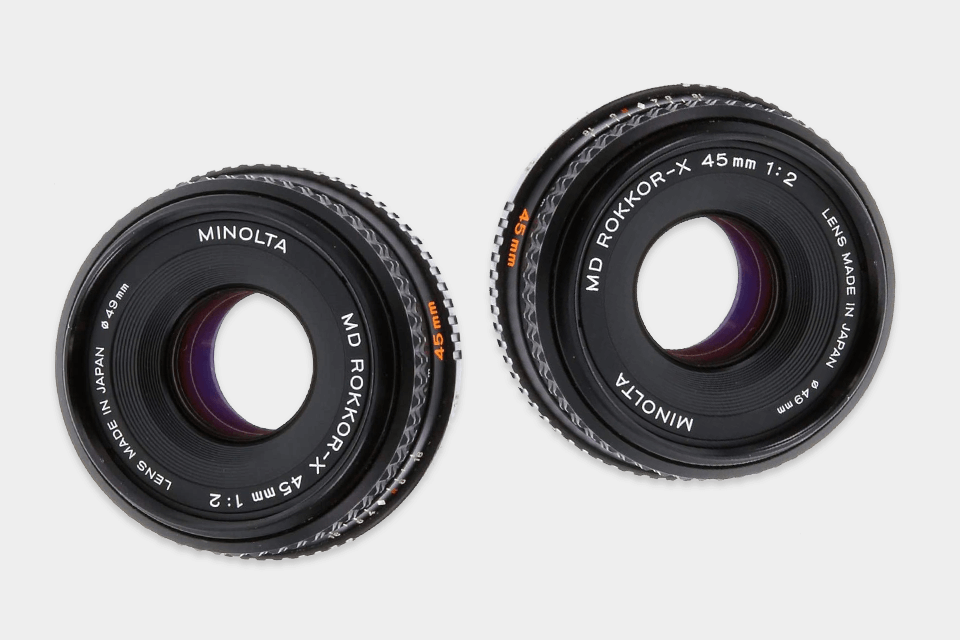
Choosing a base glass from the Minolta line is even more difficult than choosing a camera body. This brand was one of the few lens manufacturers in the world that owned a glass factory. This point is relevant today, as some Minolta autofocus lenses are still made by Sony for their A-mount cameras. You should also consider the Rokkor-X manual focus or the available Rokkor pancake lens.
You’d better get a Minolta body with the 45 mm f / 2 MD lens kit pre-installed. Be sure to check the lenses for chips or scratches, as you can’t get rid of them by polishing. In the case of vintage lenses, you may have to remove fungus from lens. This is not a conundrum if a lens is really rare and worth buying.
The first Minolta 35mm cameras had only aperture priority and manual modes. Aperture and shutter priority modes similar to those available in digital devices became available after 1977, and full program autoexposure mode in the X-series after 1981. The program mode is not mandatory for beginners, but a good help for mastering the essence of film photography.
All reviewed cameras are hybrids. On the one hand, they have some digital elements. On the other hand, they are mostly hand-held equipment. With a Minolta camera, you control the exposure and settings yourself, but the digital components will help you with this.
Fortunately, most Minolta film cameras available today are 35mm SLR, compact, or rangefinder models. Therefore, there will be no confusion with film, as you can purchase 35mm films.
The 85mm f / 2 MD Rokkor-X manual focus lens is incredibly sharp and resistant to flare, making it ideal for outdoor portraiture. The 50mm f / 1.4 MD lens has 7 elements in 6 groups, delivering stunning resolution and contrast across the entire aperture range. This is a balanced Minolta lens, sometimes the only one you need.
Almost yes. In the early 90s of the last century, Minolta merged with Konica, as previously with Leica, and later the Konica-Minolta photography collaboration was sold to Sony. For several years of the life cycle of this collaboration, the released products had a double name.